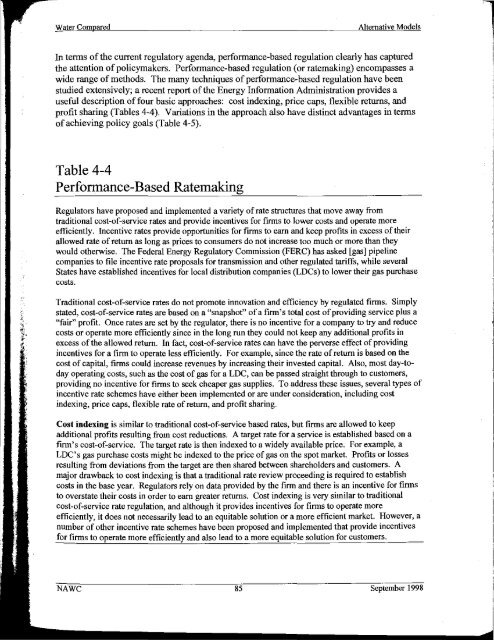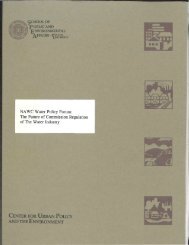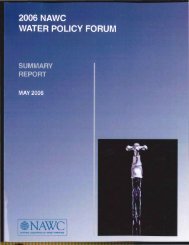BEECHER - NAWC
BEECHER - NAWC
BEECHER - NAWC
You also want an ePaper? Increase the reach of your titles
YUMPU automatically turns print PDFs into web optimized ePapers that Google loves.
Water ComparedAlternative ModelsIn terms of the current regulatory agenda, performance-based regulation clearly has capturedthe attention ofpolicymakers. Performance-based regulation (or ratemaking) encompasses awide range of methods. The many techniques of performance-based regulation have beenstudied extensively; a recent report of the Energy Information Administration provides auseful description of four basic approaches: cost indexing, price caps, flexible returns, andprofit sharing (Tables 4-4). Variations in the approach also have distinct advantages in termsof achieving policy goals (Table 4-5).Table 4-4Performance-Based RatemakingRegulators have proposed and implemented a variety of rate structures that move away fromtraditional cost-of-service rates and provide incentives for firms to lower costs and operate moreefficiently. Incentive rates provide opportunities for firms to earn and keep profits in excess of theirallowed rate of return as long as prices to consumers do not increase too much or more than theywould otherwise. The Federal Energy Regulatory Commission (FERC) has asked [gas] pipelinecompanies to file incentive rate proposals for transmission and other regulated tariffs, while severalStates have established incentives for local distribution companies (LDCs) to lower their gas purchasecosts.Traditional cost-of-service rates do not promote innovation and efficiency by regulated firms. Simplystated, cost-of-service rates are based on a "snapshot" of a firm's total cost of providing service plus a"fair" profit. Once rates are set by the regulator, there is no incentive for a company to try and reducecosts or operate more efficiently since in the long run they could not keep any additional profits inexcess of the allowed return. In fact, cost-of-service rates can have the perverse effect of providingincentives for a firm to operate less efficiently. For example, since the rate of return is based on thecost of capital, firms could increase revenues by increasing their invested capital. Also, most day-todayoperating costs, such as the cost of gas for a LDC, can be passed straight through to customers,providing no incentive for firms to seek cheaper gas supplies. To address these issues, several types ofincentive rate schemes have either been implemented or are under consideration, including costindexing, price caps, flexible rate of return, and profit sharing.Cost indexing is similar to traditional cost-of-service based rates, but firms are allowed to keepadditional profits resulting from cost reductions. A target rate for a service is established based on afirm's cost-of-service. The target rate is then indexed to a widely available price. For example, aLDC's gas purchase costs might be indexed to the price of gas on the spot market. Profits or lossesresulting from deviations from the target are then shared between shareholders and customers. Amajor drawback to cost indexing is that a traditional rate review proceeding is required to establishcosts in the base year. Regulators rely on data provided by the firm and there is an incentive for firmsto overstate their costs in order to earn greater returns. Cost indexing is very similar to traditionalcost-of-service rate regulation, and although it provides incentives for firms to operate moreefficiently, it does not necessarily lead to an equitable solution or a more efficient market. However, anumber of other incentive rate schemes have been proposed and implemented that provide incentivesfor firms to operate more efficiently and also lead to a more equitable solution for customers.<strong>NAWC</strong> 85 September 1998
















